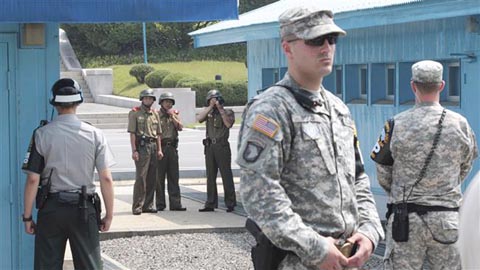
AP, Seoul :
The rival Koreas and the U.S.-led United Nations Command met Tuesday to discuss efforts to disarm a military zone the rivals control within their shared border under a peace agreement between the two countries.
The talks at the Panmunjom border village mark the first meeting between the Koreas and the U.N. Command to discuss ways to demilitarize the village’s Joint Security Area.
South Korea’s Defense Ministry said the military officials, including U.S. Army Col. Burke Hamilton, the secretary of the U.N. Command’s military armistice committee, reviewed the ongoing demining operations at the Joint Security Area and further plans to demilitarize the zone.
The Korean militaries began clearing mines from the area at the start of this month following a broad agreement meant to reduce military tensions that was forged between North Korean leader Kim Jong Un and South Korean President Moon Jae-in at their summit in September. The Koreas plan to withdraw guard posts and firearms from the Joint Security Area once the demining is complete.
At the summit in Pyongyang, the Koreas also agreed to create buffer zones along their land and sea boundaries, as well as a no-fly zone above the border, and remove 11 front-line guard posts by December. Moon and Kim also committed to reviving economic cooperation when possible, voicing optimism that international sanctions could end and allow such activity.
The Joint Security Area is overseen by the U.N. Command and by North Korea, with South Korean and North Korean border guards facing each other only meters (yards) apart. It is located inside the 4-kilometer-wide (2 ½-mile-wide) Demilitarized Zone, which is a heavily fortified zone that has formed the de facto border between the Koreas since the 1950-53 Korean War.
The Joint Security Area has been used for diplomatic engagements but was also a site of occasional bloodshed during the Cold War, including the killing of two American army officers by ax-wielding North Korean soldiers in 1976. It was also where a defecting North Korean soldier fled to the South last year in a hail of bullets fired by his former comrades.
Moon has said the military agreement is an important trust-building step that will reduce border tensions and create diplomatic space. Some military experts say South Korea is at risk of conceding some of its conventional military strength before the North takes any material steps toward giving up its nuclear weapons program, the goal of global diplomatic efforts.
South Korea’s enthusiasm for engagement with its rival also appears to have created discomfort with the United States amid growing concerns that the North is lagging behind its supposed promise to denuclearize.
South Korea last week walked back on a proposal to lift some of its unilateral sanctions against the North following a blunt retort by President Donald Trump that Seoul could “do nothing” without Washington’s approval.
South Korea’s foreign minister has also said U.S. Secretary of State Mike Pompeo expressed displeasure about the Koreas’ military agreement, fueling speculation that Washington wasn’t fully on board with the decision.
Trump has encouraged U.S. allies to maintain sanctions and pressure on North Korea until it denuclearizes. North Korea’s state media on Tuesday criticized Washington’s position, saying it threatens to erase the trust that has supposedly been created in high-level talks so far.

